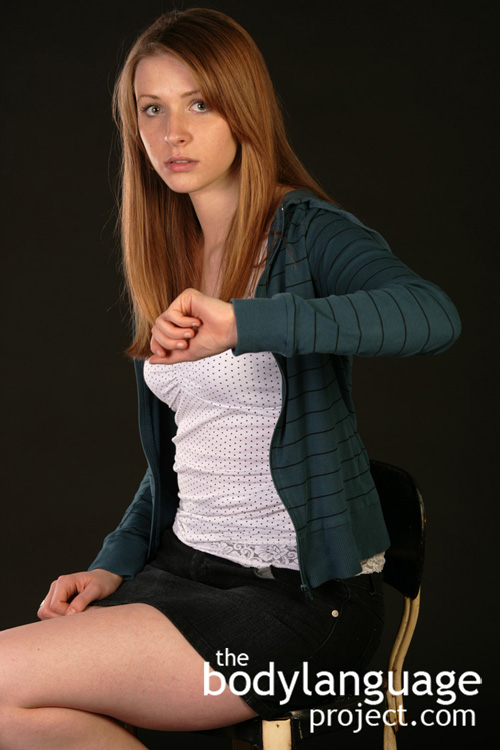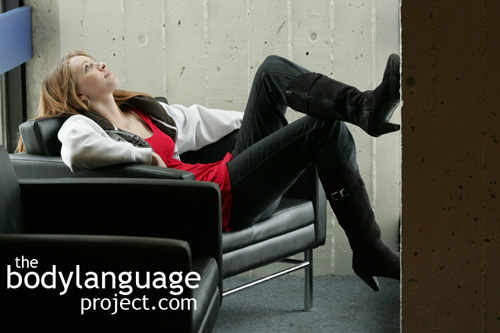Body Language of Toe Pointing or Pointed Toe

 Cue: Toe Pointing or Pointed Toe.
Cue: Toe Pointing or Pointed Toe.
Synonym(s): Pointed Toe, Foot Pointing, Feet Indicating, Feet Toward, Feet Away, Goodbye Feet, Honest Feet, Foot Pointing Language.
Description: When the feet point toward the direction they wish to travel.
In One Sentence: Toes are believed to subconsciously signal the direction in which people wish to travel, or in the direction in which they are thinking.
How To Use it: Foot pointing usually goes unnoticed, however, to show intimacy and focus, orient the entire body toward the person who you wish to express your undivided attention. This works well in business, dating, as well as other relationships. Showing others that they have your nonverbal attention is much more powerful than simply lending an ear or an eye. Despite the cue being out of usual awareness, it is quite likely that others will pick up on your cue and ascribe to you positive attributes. See Meaning and/or Motivation for more ideas about constructive uses for foot pointing.
Context: a) General b) Dating.
Verbal Translation: “My feet are honest and point in the direction I wish to travel.”
Variant: See Arm Withdrawal or Leg Withdrawal.
Cue In Action: a) In his excitement, he failed to realize that his buddy really needed to get going. His buddy’s head began to drag backwards, his torso faced away, and his feet were aimed away from him and toward his car. His body language really said that he needed to get going. b) He wasn’t interested and wanted to leave – his feet slowly inched toward the doorway rather than toward her. On the other hand, her feet were directly facing, and extended, in his direction. The affection was not mutual.
Meaning and/or Motivation: Feet are intension cues because they are the earliest indicators of where the mind wishes to go. Feet point to doorways when someone wants to leave and away from people they do not agree with. If feet are pointed away from you, it’s a strong indicator that a person wishes to be elsewhere.
It has been said that the feet are the most honest part of the body as it applies to the language they emit. Millions of years ago, we gave up quadrupedalism to walk upright, leaving our feet to the dirt. While our hands busied themselves with other complex tasks like fire building, making clothing, shelters and throwing spears, our legs were relegated to more primitive activities like locomotion.
The feet have always carried out more traditional tasks like escaping predators, avoiding hot sand or coals from a fire, leaping from slithering snakes or poisonous spiders, or navigating rough rocking river bottoms. The feet were therefore connected more to the reptilian brain that reacts to stimuli directly. The feet don’t contemplate higher order tasks that require planning.
Feet, therefore, make great predictors of behaviour. For example, we know that children are interested in play rather then eating when their legs bounce at the dinner table. Their feet bounce up and down as they quickly gobble their food so they don’t miss the action. Even if feet don’t fidget they will still point, or inch toward the door in effort to prepare for escape. Therefore, the feet of adults reveal true emotions by pointing away from boring conversations and towards things they find attractive or stimulating.
Cue Cluster: Usually the torso also tends to aim in the direction of desired travel, along with the head. Conversations will begin to dry up, agreement indicators either speed up to quicken the conversation or slow down if there is little more to say. Barriers like arm crossing or partial arm crossing will accompany the foot indication.
Body Language Category: Body pointing, Disengagement body language, Dislike (nonverbal), Disapproval cues, Distancing or moving away, Escape movements, Indicators of disinterest (IOD), Indicator of interest (IoI), Intention movements, Orienting reflex or orienting response (a), Rejection body language, Ready language.
Resources:
Astrom, Jan. Introductory greeting behavior: a laboratory investigation of approaching and closing salutation phases. Perceptual and Motor Skills. 1994. 79(2): 863(35).
Aiello, J. 1977. A further look at equilibrium theory. Visual interaction as a function of
interpersonal distance. Environmental Psychology & Nonverbal Behavior, 1: 122-140.
Argyle, M., & Dean, I. Eye contact, distance and affiliation. Sociometry, 1965, 28, 289-304.
Boucher, Michael L. Holzberg, Jules D. (editor). Effect of seating distance on interpersonal attraction in an interview situation. Journal of Consulting and Clinical Psychology. 1972 38(1): 15-19.
Broth, Mathias and Lorenza Mondada. Walking Away: The Embodied Achievement of Activity Closings in Mobile Interaction. Journal of Pragmatics. 2013. 47: 41-58.
http://bodylanguageproject.com/articles/nonverbally-negotiate-conversation-walking-away/
Bania, Amanda E. ; Stromberg, Erin E. Call, Joseph (editor). The Effect of Body Orientation on Judgments of Human Visual Attention in Western Lowland Gorillas.
Journal of Comparative Psychology. 2013. 127(1): 82-90.
Belhiah, Hassan. Tutoring as an embodied activity: How speech, gaze and body orientation are coordinated to conduct ESL tutorial business. Journal of Pragmatics. 2009. 41(4): 829-841.
Beaulieu, Catherine. Intercultural Study of Personal Space: A Case Study. Journal of Applied Social Psychology. 2004 34(4):794-805.
Baxter, James C. ; Rozelle, Richard M. Lanzetta, John T. (editor). Nonverbal expression as a function of crowding during a simulated police-citizen encounter. Journal of Personality and Social Psychology. 1975. 32(1): 40-54.
Cook, M. Experiments on orientation and proxemics. Human Relations, 1970, 23, 61-67.
Clack, B., Dixon, J., & Tredoux, C. (2005). Eating together apart: Patterns of segregation in a multi-ethnic cafeteria. Journal of Community & Applied Social Psychology, 15, 1-16. doi:10.1002/casp.787
Castelli, Luigi ; Carraro, Luciana ; Pavan, Giulia ; Murelli, Elisa ; Carraro, Alessia. The Power of the Unsaid: The Influence of Nonverbal Cues on Implicit Attitudes. Journal of Applied Social Psychology. 2012 42(6): 1376-1393.
Coutts, Larrym. ; Ledden, Maribeth. Nonverbal Compensatory Reactions to Changes in Interpersonal Proximity. The Journal of Social Psychology. 1977 102(2): 283-290.
Chance RMA (1962) An interpretation of some agonistic postures: the role of “cut-off” acts and postures. Symp Zool Soc Lond 8: 71–89.
Cacioppo, J. T., Hawkley, L. C., Crawford, L. E., Ernst, J. M., Burleson, M. H., Kowalewski, R. B., et al. (2002). Loneliness and health: Potential mechanisms. Psychosomatic Medicine. 2002; 64: 407-417.
Cook, Mark. 1970. Experiments on orientation and proxemics. Human Relations 23 (1): 61-76.
Dowell, Nia M. and Jeffrey S. Berman. Therapist Nonverbal Behavior and Perceptions of Empathy, Alliance, and Treatment Credibility. Journal of Psychotherapy Integration. 2013. 23(2): 158-165. DOI: 10.1037/a0031421. http://bodylanguageproject.com/articles/lean-make-eye-contact-create-impressions-empathy-leaning-body-language-creates-greater-credibility
Dolphin, Carol Zinner. Beyond hall: Variables in the use of personal space in intercultural transactions. Howard Journal of Communications. 1988. 1(1): 23-38.
Eerland, Anita; Tulio M. Guadalupe; Ingmar H. A. Franken and Rolf A. Zwaan. Posture as Index for Approach-Avoidance Behavior. PLOS one. February 2012. 7(2): e31291.
http://bodylanguageproject.com/articles/approach-versus-avoidance-posture-in-nonverbal-body-language/
Felipe, N. Interpersonal distance and small group interaction. Cornell Journal of Social Relations, 1966, 1, 59-64.
Felipe, N. Connotations of seating arrangements. Cornell Journal of Social Relations, 1967, 2, 37-44.
Gifford, Robert ; O’Connor, Brian. Nonverbal intimacy: Clarifying the role of seating distance and orientation. Journal of Nonverbal Behavior. 1986 10(4): 207-214.
Gardin, Hershel ; Kaplan, Kalman J. ; Firestone, Ira J. ; Cowan, Gloria A. Lanzetta, John T. (editor). Proxemic effects on cooperation, attitude, and approach-avoidance in a Prisoner’s Dilemma game. Journal of Personality and Social Psychology. 1973. 27(1): 13-18.
Gregersen, Tammy S. Nonverbal Cues: Clues to the Detection of Foreign Language Anxiety. Foreign Language Annals. 2005. 38(3): 388-400
http://bodylanguageproject.com/articles/what-anxious-learners-can-tell-us-about-anxious-body-language-how-to-read-nonverbal-behavior/
Girard, Jeffrey M.; Jeffrey F. Cohna; Mohammad H.Mahoor S.; Mohammad Mavadati;
Zakia Hammal; and Dean P. Rosenwalda. Nonverbal Social Withdrawal In Depression: Evidence From Manual And Automatic Analyses. Image and Vision Computing. 2013.
http://bodylanguageproject.com/articles/body-language-signals-withdrawal-depression/
Goodboy, Alan, K. and Maria Brann. Flirtation Rejection Strategies: Towards an Understanding of Communicative Disinterest in Flirting. The Quantitative Report. 2010. 15(2): 268-278.
http://bodylanguageproject.com/articles/how-to-reject-flirting-using-nonverbal-and-verbal-tactics/
Gunderson, Virginia M. ; Lockard, Joan S. Human postural signals as intention movements to depart: African data. Animal Behaviour. 1980 28(3): 966-967.
Greenberg, Carl I. ; Firestone, Ira J. Greenwald, Anthony G. (editor). Compensatory responses to crowding: Effects of personal space intrusion and privacy reduction. Journal of Personality and Social Psychology. 1977. 35(9): 637-644.
Graziano, Michael S.A. and Cooke, Dylan F. Parieto-frontal interactions, personal space, and defensive behavior. Neuropsychologia. 2006. 44(6): 845-859.
Holt, Daphne J ; Cassidy, Brittany S ; Yue, Xiaomin ; Rauch, Scott L ; Boeke, Emily A ; Nasr, Shahin ; Tootell, Roger B H ; Coombs, Garth. Neural correlates of personal space intrusion. The Journal of neuroscience : the official journal of the Society for Neuroscience. 2014. 34(12): 4123-34.
Harrigan, Jinni ; Oxman, Thomas ; Rosenthal, Robert. Rapport expressed through nonverbal behavior. Journal of Nonverbal Behavior. 1985 9(2): 95-110.
Hall, Jeffrey A. and Chong Xing. The Verbal and Nonverbal Correlates of the Five Flirting Styles. Journal of Nonverbal Behavior. 2015. 39:41–68. DOI 10.1007/s10919-014-0199-8
http://bodylanguageproject.com/articles/first-12-minutes-flirting-using-nonverbal-communication-study-reveals-26-body-language-cues-attraction/
Haase, Richard F. ; Dimattia, Dominic J. Berdie, Ralph F. (editor). Proxemic behavior: Counselor, administrator, and client preference for seating arrangement in dyadic interaction. Journal of Counseling Psychology. 1970 17(4): 319-325.
IJzerman, Hans; Marcello Gallucci; Wim T.J.L. Pouw; Sophia C. Weigerber; Niels J. Van Doesum and Kipling D. Williams. Cold-Blooded Loneliness: Social Exclusion Leads To Lower Skin Temperatures. Acta Psychologica. 2012. 140:283-288. http://bodylanguageproject.com/articles/body-temperature-actually-drops-during-social-exclusion/
Kenner, Andrew N. ; Katsimaglis, George. Gender differences in proxemics: taxi-seat choice. Psychological Reports. 1993 72(2): 625(2).
Katza, Carmit; Irit Hershkowitz; Lindsay C. Malloya; Michael E. Lamba; Armita Atabakia and Sabine Spindlera. Non-Verbal Behavior of Children Who Disclose or do not Disclose Child Abuse in Investigative Interviews. Child Abuse & Neglect. 2012. 36: 12-20.
http://bodylanguageproject.com/articles/reading-nonverbal-behaviour-child-abuse-cases-encourage-children-divulge-information-truth-telling/
Moore, Monica. Courtship Signaling and Adolescents: Girls Just Wanna Have Fun. Journal of Sex Research. 1995. 32(4): 319-328.
http://bodylanguageproject.com/articles/girls-just-want-to-have-fun-the-origins-of-courtship-cues-in-girls-and-women/
Navarro, Joe. 2008. What Every BODY is Saying: An Ex-FBI Agent’s Guide to Speed-Reading People. William Morrow Paperbacks.
Remland, M. S. and T. S. Jones 1995. Interpersonal Distance, Body Orientation, and Touch: Effects of Culture, Gender, and Age. Journal of Social Psychology 135(3): 281-297.
Remland, Martins. ; Jones, Tricias. ; Brinkman, Heidi. Interpersonal Distance, Body Orientation, and Touch: Effects of Culture, Gender, and Age. The Journal of Social Psychology. 1995 135(3): 281-297.
Hietanen, Jari. Social attention orienting integrates visual information from head and body orientation. Psychological Research.2002 66(3): 174-179.
Harrigan J. and Rosenthal R. Physicians’ head and body positions as determinants of perceived rapport. J. appl. Sot. Psychol. 13, 496, 1983.
Kaminski, Juliane ; Call, Josep ; Tomasello, Michael. Body orientation and face orientation: two factors controlling apes’ begging behavior from humans. Animal Cognition. 2004. 7(4): 216-223.
Langton, S. R. H., & Bruce, V. (2000). You must see the point: Automatic processing of cues to the direction of social attention. Journal of Experimental Psychology: Human Perception and Performance, 26, 747–757.
Lockard, J.S. ; Allen, D.J. ; Schiele, B.J. ; Wiemer, M.J. Human postural signals: Stance, weight-shifts and social distance as intention movements to depart. Animal Behaviour. 1978 26: 219-224.
Lawson, Rebecca P. ; Clifford, Colin W. G. ; Calder, Andrew J. About Turn: The Visual Representation of Human Body Orientation Revealed by Adaptation. Psychological Science. 2009. 20(3): 363(9).
Montgomery, Derek ; Moran, Christy ; Bach, Leslie. The influence of nonverbal cues associated with looking behavior on young children’s mentalistic attributions.
Journal of Nonverbal Behavior. 1996. 20(4): 229-249.
Mcelroy, James C. ; Morrow, Paula C. Personal space, personal appearance, and personal selling. Psychological Reports. 1994 74(2): 425(2).
Mcgurk, Barry J. ; Davis, John D. ; Grehan, John. Assaultive behavior personality and personal space. Aggressive Behavior. 1981. 7(4): 317-324.
Navarro, Joe. A four-domain model for detecting deception: an alternative paradigm for interviewing. The FBI Law Enforcement Bulletin. 2003. 72(6): 19(6).
Newman, Robert C. ; Pollack, Donald Holzberg, Jules D. (editor). Proxemics in deviant adolescents. Journal of Consulting and Clinical Psychology. 1973 40(1): 6-8.
Robinson, Jeffrey David. Getting Down to Business Talk, Gaze, and Body Orientation During Openings of Doctor-Patient Consultations. Human Communication Research. 1998. 25(1): 97-123.
Straube, Benjamin ; Green, Antonia ; Jansen, Andreas ; Chatterjee, Anjan ; Kircher, Tilo. Social cues, mentalizing and the neural processing of speech accompanied by gestures. Neuropsychologia. 2010. 48(2): 382-393.
Sartori, Luisa ; Becchio, Cristina ; Castiello, Umberto. Cues to Intention: The Role of Movement Information. Cognition. 2011. 119(2): 242-252.
Scherer, S. E., & Schiff, M. R. Perceived intimacy, physical distance, and eye contact. Perceptual and Motor Skills, 1973, 36, 835-841.
Scott, J. A. Comfort and seating distance in living rooms: The relationship of interactants and topic of conversation. Environment and Behavior, 1984, 16, 35-54.
Sommer, R. Studies in personal space. Sociometry, 1959, 22,247-260.
Sommer, R. The distance for comfortable conversation: A further study. Sociometry, 1962, 25, 111-116.
Sommer, R. Personal space: The behavioral basis of design. Englewood Cliffs, New Jersey: Prentice Hall. 1969.
Sporer, Siegfried L. ; Schwandt, Barbara Penrod, Steven D. (editor). Moderators of Nonverbal Indicators of Deception: A Meta-Analytic Synthesis. Psychology, Public Policy, and Law. 2007. 13(1): 1-34.
Underwood, M. K.. Glares of Contempt, Eye Rolls of Disgust and Turning Away to Exclude: Non-Verbal Forms of Social Aggression among Girls. Feminism & Psychology. 2004 14(3): 371-375
Uchino, B. N., Cacioppo, J. T., & Kiecolt-Glaser, J. K. (1996). The Relationship Between Social Support And Psychological Processes: A Review With Emphasis On Underlying Mechanisms And Implications For Health. Psychological Bulletin. 1996; 119: 488-531.
Wicker, B., Michel, F., Henaff, M.-A., & Decety, J. (1998). Brain regions involved in the perception of gaze: A PET study. Neuroimage, 8, 221–227.
Willis, F. 1966. Initial speaking distance as a function of the speaker’s relationship. Psychonomic Science. 5: 221-222.
Weiss, M., & Keys, C. The influence of proxemic variables on dyadic interaction between peers. Paper presented at the meeting of the American Psychological Association; Chicago, 1975, August.
Werner, Carol ; Brown, Barbara ; Damron, Gary Steiner, Ivan D. (editor). Territorial marking in a game arcade. Journal of Personality and Social Psychology. 1981. 41(6): 1094-1104.
 Cue: Undershaker Handshake (The)
Cue: Undershaker Handshake (The)





